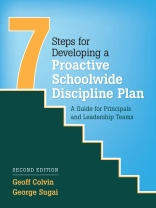In Pursuit of Positive and Proactive Behaviors – The Challenge
Every school wants to provide a safe, preventive, and positive learning environment, but recent shifts in societal and cultural norms have given rise to reactions that can be injurious, uncivil, and discriminatory. Creating and maintaining positive and proactive school discipline plans while preserving societal values and norms is more challenging than ever. Urges to get toughand enact zero tolerance policies may give impetus, but not tools. Schools are often left wondering how to address problematic behaviors, make real change happen, and accomplish their intended goals.
Seven Steps shows practitioners and pre-service educators what, why, and how to build effective school-wide discipline practices using both data and documented successes. It offers a step-by-step process that maximizes teaching and learning and prevents problem behavior while establishing and maintaining desirable behavior to enhance school success. Seven procedural steps show how to:
· Develop, teach, and maintain schoolwide behavior expectations
· Correct problem behaviors
· Sustain your plan for the long haul
Get started in creating a positive and supportive environment by exposing students to the best possible practices by all teachers in all settings.
Inhoudsopgave
Prologue
About the Authors
Introduction
SECTION I: FOUNDATIONS
1. Guiding Principles in Providing Quality Education for All Students
Guiding Principle One: Secure Active and Integrated Participation and Support From All Levels of Stakeholders
Guiding Principle Two: Ensure That School Principal Is an Effective Instructional Leader and Active Participant in All Implementation
Guiding Principle Three: Develop Systems to Ensure All Students Have Access to the Best Instructional and Behavioral Practices for School Success
Guiding Principle Four: Implement Instructional and Behavior Practices and Systems Concurrently Within Multitiered Support Continuum
Guiding Principle Five: Implement Support Systems With Fidelity to Ensure Sustainability
Guiding Principle Six: Use Positive Reinforcement Judiciously
Guiding Principle Seven: Manage Data Effectively and Efficiently
Guiding Principle Eight: Utilize a Building Leadership Team-Based Approach
Guiding Principle Nine: Consider Context and Culture When Implementing Procedural Details
2. Understanding the Teaching–Learning Process
Stages Involved in the Process of Learning a Skill
SECTION II: COMPONENTS OF A PROACTIVE SCHOOLWIDE DISCIPLINE PLAN
3. Step 1: Getting Started
Conduct Preliminary Schoolwide Discipline Plan Survey
Establish a Leadership Team
Establish Need for the Plan
Communicate Effectiveness of the Plan
Explore How Plan Can Mesh With School Goals and With Other Plans
Assess District’s and Schools’ Capacity to Implement the Plan
Present Roles and Responsibilities for Implementation
Provide Opportunities for Full Discussion
Plan for the Long Haul
Obtain Commitment From All Stakeholders
Develop a Comprehensive Professional Development Plan
Develop and Use a Self-Assessment Checklist for Implementation Action Planning
4. Step 2: Developing Schoolwide Behavior Expectations
Adopting Guidelines for Selecting Schoolwide Behavior Expectations
Applying Schoolwide Behavior Expectations to Major Common Areas in the School
5. Step 3: Teaching the Behavior Expectations
Teaching Behavior Expectations to Younger Students (K–3)
Teaching Behavior Expectations to Older Students (Grades 4–12) and a Maintenance Teaching Plan for Younger Students
Generalizing the Teaching to All Common Areas
6. Step 4: Maintaining the Behavior Expectations
Systematic Review
Modeling by Faculty Through Informal Practices
Schoolwide Recognition Plans
7. Step 5: Correcting Problem Behavior
A System Involving a Continuum of Responses for the Full Range of Problem Behavior
Overview of Continuum of Responses for Addressing Problem Behavior
Office-Managed Behavior
Staff-Managed Behavior
8. Step 6: Using Data Effectively
Defining the Role of the Leadership Team
Clarifying the Purposes of an Effective Data Management System
Establishing Guidelines in Developing a Data Management System
9. Step 7: Sustaining the Plan for the Long Haul
Implementation Phases and Drivers
General Implementation-Stage Logic Based on Action Planning
Ongoing Process Factors
PBIS Exemplar for Sustainability
Ongoing Refresh Meetings to Sustain the Plan
Future Directions
Concluding Remarks
Appendices (Appendices A-Q, Reproducible Checklists, Plans, and Forms)
References
Credits
Index
Over de auteur
George Sugai is Professor and Carole J. Neag Endowed Chair in the Neag School of Education, Department of Educational Psychology at the University of Connecticut. His research and practice interests include school-wide positive behavior support, behavioral disorders, applied behavior analysis, classroom and behavior management, and school discipline. He has been a classroom teacher, program director, personnel preparer, and applied researcher. Dr. Sugai has a noteworthy publi¬cation record in refereed journals having published over 130 peer-reviewed articles, numerous monographs, and five college textbooks on effective teaching practices and Applied Behavior Analysis. He presented at numerous local, national, and international conferences and professional meetings, and has served as advisor to the U.S. Departments of Education, Justice, and Health and Human Services. His international work includes projects and consultation in eleven countries. He is co-director of the OSEP Center on Positive Behavioral Interventions and Supports (PBIS), research scientist in the UConn Center on Behavioral Education and Research, and co-director of the OSEP Early Childhood Personnel Center.












